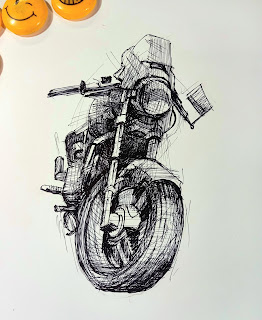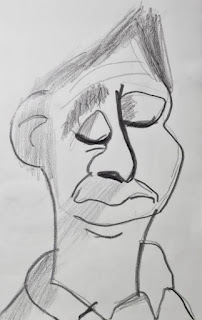Estudos rápidos com pincel/caneta Quick Studies with Brush Pen
Estudos rápidos com pincel/caneta
15 de setembro de 2025
Este é um exercício muito eficiente e divertido, que aplicamos tanto nas aulas presenciais quanto nas online. É prático, rápido e prazeroso para o aluno, além de ser um excelente recurso para soltar a mão e estimular a criatividade.
Utilizamos folhas sulfite e um pincel/caneta do tipo soft brush pen, bastante usado em aquarela. A ideia é treinar de forma simples, sem grandes preparações, para que o foco esteja no gesto e na criação.
Quando o aluno já alcança o nível intermediário e tem um bom domínio da anatomia, iniciamos esse treino com uma proposta ainda mais criativa: vários estudos aleatórios, priorizando a imaginação e a construção de personagens.
Os temas são sempre variados — personagens medievais, guerreiros, soldados, monstros saídos do imaginário e até alienígenas. O mais importante é se divertir e brincar com as possibilidades, sem cobranças excessivas.
Nos primeiros estudos, buscamos leveza: pinceladas soltas que revelam silhuetas simples e chapadas, em apenas uma cor. Não há necessidade de definição ou acabamento nessa etapa. O essencial é capturar o gesto, a atitude e o equilíbrio das proporções. Produzimos muitos esboços e, só depois, escolhemos os mais interessantes para refinar.
Na etapa seguinte, damos mais identidade ao personagem. A partir dos melhores gestos e proporções, começamos a lapidar: acrescentamos roupas, capas, espadas, escudos, acessórios e pequenos detalhes que dão vida à figura. Não é sobre exagerar, mas sim sobre valorizar o estilo, a pose e a personalidade.
Esse é um treino extremamente eficaz, que acelera a evolução do desenho e expande a imaginação de forma natural.
Se você gosta de dicas como esta, me acompanhe também no Instagram: @jerrygraciano.
Obrigado por visitar o blog — volte sempre!
This is a very efficient and fun exercise, which we apply both in face-to-face and online classes. It’s practical, quick, and enjoyable for the student, while also being an excellent resource to loosen up the hand and stimulate creativity.
We use regular paper and a soft brush pen, the kind often used in watercolor. The idea is to practice in a simple way, without too much preparation, so that the focus stays on gesture and creation.
When the student reaches an intermediate level and has a solid grasp of anatomy, we start this training with a more creative approach: a series of random studies, prioritizing imagination and character building.
The themes are always varied — medieval characters, warriors, soldiers, monsters from the imagination, and even aliens. The most important thing is to have fun and play with the possibilities, without unnecessary pressure.
In the first studies, we aim for lightness: loose strokes forming simple, flat silhouettes in just one color. There’s no need for detail or polish at this stage. What matters is capturing the gesture, the attitude, and the balance of proportions. We produce many sketches and only later select the most interesting ones to refine.
In the next stage, we give more identity to the character. From the best gestures and proportions, we start polishing: adding clothes, capes, swords, shields, accessories, and small details that bring the figure to life. It’s not about exaggerating, but about enhancing style, pose, and personality.
This is an extremely effective practice that accelerates drawing progress and naturally expands imagination.
If you enjoy tips like this, follow me on Instagram: @jerrygraciano.
Thank you for visiting the blog — come back anytime!




Comentários
Postar um comentário